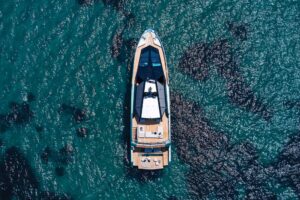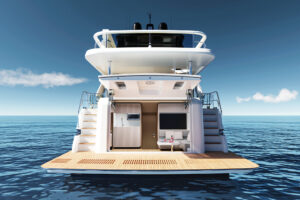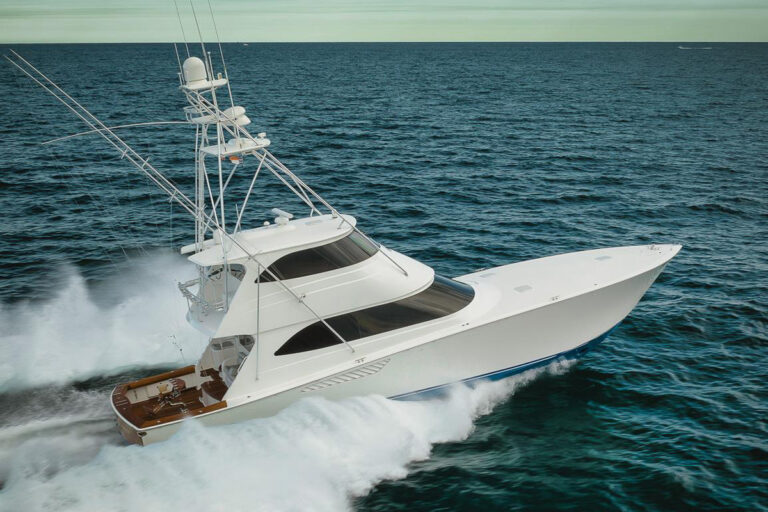Cavileer Boatworks, while working to create a line of distinctive convertibles, takes a page from cruising yacht design. The philosophy is to build boats that maximize interior space while remaining seaworthy in all conditions, a mission marine architect Donald Blount seems to have met when designing the new 48 Convertible.
You will not be surprised that I found the 48 more than up to the task of besting the 5-knot breeze that whipped the Connecticut River into raging ripples on the day of my sea trial aboard hull number three. Upriver, 20 miles north of Long Island Sound, is not a true test for a rugged sportfisherman, but my time on board reinforced my first impression that the 48 differs from what many anglers might expect.
Her beam is slightly more than 16 feet at its widest, and the taper associated with vessels of similar ilk is missing. In hip-hop terms, this baby got back, with a 13-foot, 10-inch transom that prevents the cockpit from inappropriately dwindling. Even without outriggers, the 48 looks fishy.
She has minimal flare and hardly any flam, the exaggerated flare seen in the uppermost portion of some hulls. Describing the hull as a straight drop from rub rail to boot stripe would be an embellishment, but only a slight one. How that correlates to head sea handling and dryness, I could not determine from my ride, but Blount reiterated more than once that those issues are dealt with below the waterline. If the chine and integral spray rails work according to design, the hull sides are not needed to deflect spray and are not factors in entry. This hull has a 201/2-degree deadrise amidships that flattens to 12 degrees at the transom.
In running profile, the 48 displaces water evenly, and the chine just forward of the deckhouse seems to gently fold the bow wake away from the hull. The hull’s boldness does not compromise her appeal. Upon careful dissection, she offers reminders of classic fishboats. This is not by accident. The builder and designer set out to create a hybrid that retained the distinct qualities made famous by regional builders.
Construction techniques are conventional. The hull bottom is handlaid solid glass giving way to balsa-core in the sides, deck and bridge. The saloon sole is built with 2-inch Nidacore, chosen for its strength and insulation qualities.
Belowdecks, the engines are atop steel mounts. They are positioned farther aft than on the prototype, which did not satisfy Cavileer in terms of handling characteristics and balance. Other changes included increases in rudder size and fuel capacity, from 700 to 750 gallons, housed in one main and one auxiliary aluminum tank.
Our test boat had a pair of 700 hp Caterpillar C-12s. The 48 glided up on plane to a 32-knot top end. Cruising speed (Cat recommends 200 rpm off the top; I prefer 300 rpm) in the 25-knot-plus range will be economical and comfortable, more than satisfactory for cruising and fishing. Long-distance runners wanting more push might opt for the 800 hp Cats or the 825 hp Series 60 Detroit Diesels. I would go that route for the additional responsiveness needed to fight fish, run an inlet or jump out of the hole.
Poking around the engineroom is easy, with more than 5 feet of headroom and 2 feet, 8 inches of crawl space outboard of the diesels. The optional emergency pump system is neatly rigged forward of the main engines with a Y-valve for quick use. The raw-water intakes in the same area come without internal sea strainers.
The compartment’s overhead is a clean one-piece unit, but it does not provide secondary access from the saloon. If a catastrophic failure occurs, there is a pattern in place for removal of the saloon sole. The manufacturer prefers this setup for sound reduction in the saloon, where I found decibel levels quite acceptable.
The finish in our test boat’s engineroom was above average. All openings were finished with rubber gaskets, everything was labeled and all clamps were tightened with their fittings in uniform positions. The 10kW Kohler generator was housed in the machinery area.
Ascending the ladder to the flying bridge and helm, I found the rear section of the cutout’s overhang a bit awkward and tight. Girth-challenged skippers might request an adjustment. On the other hand, once at the helm, you will have a clear line of sight to the bow thanks to a notch in the forward section of the bridge. Even children will have a bird’s-eye view of the pulpit. The layout in this area is typical, with an insulated box for a battery of beverages, a settee with gear stowage, and a generous flat surface for electronics.
As intended by her designers, the 48’s full figure is most evident in her saloon and three staterooms, which are not only voluminous, but tastefully appointed. Our test boat’s teak joinery and fit and finish were clean and on par with competitive convertibles. The saloon layout has an L-shape settee facing forward, giving all guests a clear view of the entertainment area, galley and dinette. Cavileer is billed as a semi-custom yard and will make modifications for an owner’s needs where possible.
All galley appliances are tucked behind doors and under counters when not in use. Provisions are stowed under the dinette seating and saloon settee, as well as within the custom cabinetry.
A wide companionway leads to the living quarters, with natural light beaming down from hatches in the guest and master heads. The master head has twin sinks with enough room for two people. Within the guest shower stall is stowage for a few towels or supplies, a feature I wish I had in my home bathroom.
The living spaces have 6 feet, 5 inches of headroom and allow for clear walkways around, in between and in front of the berths. The master cabin is not designed at the mercy of the 48’s bow flare. A washer/dryer is in the starboard guest cabin’s closet, with enough room to use it.
I would be remiss if I failed to give the 163-square-foot cockpit some ink. The fishbox is large and off-center to port. The lazarette is accessed from a separate deck hatch to starboard, so having 500 pounds of tuna in the box will not restrict reaching the area below in a hurry. All connections for dockside service are readily accessible, as are all washdown receptacles and the bait prep area.
If you like what Cavileer is offering in the 48 but want a shorter LOA, watch for an upcoming 43, already on Blount’s drawing board.
Contact: Cavileer Boatworks, (609) 965-8650; cavileeryachts@aol.com; www.cavileer.com.









